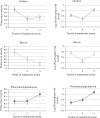Metabolomic study of carotid-femoral pulse-wave velocity in women
- PMID: 25490711
- PMCID: PMC4354457
- DOI: 10.1097/HJH.0000000000000467
Metabolomic study of carotid-femoral pulse-wave velocity in women
Abstract
Objective: Carotid-femoral pulse-wave velocity (PWV) is a measure of aortic stiffness that is strongly associated with increased risk of cardiovascular morbidity and mortality. The aim of the current study was to identify the molecular markers and the pathways involved in differences in PWV in women, in order to further understand the regulation of arterial stiffening.
Methods: A total of 280 known metabolites were measured in 1797 female twins (age range: 18-84 years) not on any antihypertensive medication. Metabolites associated with PWV (after adjustment for age, BMI, metabolite batch, and family relatedness) were entered into a backward linear regression. Transcriptomic analyses were further performed on the top compounds identified.
Results: Twelve metabolites were associated with PWV (P < 1.8 × 10). One of the most strongly associated metabolites was uridine, which was not associated with blood pressure (BP) and traditional risk factors but correlated significantly with the gene-expression levels of the purinergic receptor P2RY2 (Beta = -0.010, SE = 0.003, P = 0.007), suggesting that it may play a role in regulating endothelial nitric oxide synthase phosphorylation. On the other hand, phenylacetylglutamine was strongly associated with both PWV and BP.
Conclusion: Circulating levels of uridine, phenylacetylglutamine, and serine appear strongly correlated with PWV in women.
Figures
Comment in
-
Combining -omics in the search for mechanisms in complex trait diseases.J Hypertens. 2015 Apr;33(4):698-9. doi: 10.1097/HJH.0000000000000508. J Hypertens. 2015. PMID: 25915872 No abstract available.
Similar articles
-
Novel Metabolites Are Associated With Augmentation Index and Pulse Wave Velocity: Findings From the Bogalusa Heart Study.Am J Hypertens. 2019 May 9;32(6):547-556. doi: 10.1093/ajh/hpz046. Am J Hypertens. 2019. PMID: 30953049 Free PMC article.
-
The impact of age and risk factors on carotid and carotid-femoral pulse wave velocity.J Hypertens. 2015 Jul;33(7):1446-51. doi: 10.1097/HJH.0000000000000582. J Hypertens. 2015. PMID: 26039533
-
Plasma Metabolome Predicts Aortic Stiffness and Future Risk of Coronary Artery Disease and Mortality After 23 Years of Follow-Up in the General Population.J Am Heart Assoc. 2024 May 7;13(9):e033442. doi: 10.1161/JAHA.123.033442. Epub 2024 Apr 19. J Am Heart Assoc. 2024. PMID: 38639368 Free PMC article.
-
Reference Values of Carotid Ultrafast Pulse-Wave Velocity: A Prospective, Multicenter, Population-Based Study.J Am Soc Echocardiogr. 2021 Jun;34(6):629-641. doi: 10.1016/j.echo.2021.01.003. Epub 2021 Jan 7. J Am Soc Echocardiogr. 2021. PMID: 33422666
-
The Association between Inflammation and Pulse Wave Velocity in Dyslipidemia: An Evidence-Based Review.Mediators Inflamm. 2020 Aug 18;2020:4732987. doi: 10.1155/2020/4732987. eCollection 2020. Mediators Inflamm. 2020. PMID: 32908450 Free PMC article. Review.
Cited by
-
Diagnosing Arterial Stiffness in Pregnancy and Its Implications in the Cardio-Renal-Metabolic Chain.Diagnostics (Basel). 2022 Sep 14;12(9):2221. doi: 10.3390/diagnostics12092221. Diagnostics (Basel). 2022. PMID: 36140621 Free PMC article. Review.
-
The role of chronic kidney disease-associated dysbiosis in cardiovascular disease.Exp Biol Med (Maywood). 2019 Apr;244(6):514-525. doi: 10.1177/1535370219826526. Epub 2019 Jan 25. Exp Biol Med (Maywood). 2019. PMID: 30682892 Free PMC article. Review.
-
Gut microbiota in hypertension.Curr Opin Nephrol Hypertens. 2015 Sep;24(5):403-9. doi: 10.1097/MNH.0000000000000149. Curr Opin Nephrol Hypertens. 2015. PMID: 26125644 Free PMC article. Review.
-
Integrated multiomics approach identifies calcium and integrin-binding protein-2 as a novel gene for pulse wave velocity.J Hypertens. 2016 Jan;34(1):79-87. doi: 10.1097/HJH.0000000000000732. J Hypertens. 2016. PMID: 26378684 Free PMC article.
-
Central systolic pressure and a nonessential amino acid metabolomics profile: the African Prospective study on the Early Detection and Identification of Cardiovascular disease and Hypertension.J Hypertens. 2019 Jun;37(6):1157-1166. doi: 10.1097/HJH.0000000000002040. J Hypertens. 2019. PMID: 30801385 Free PMC article.
References
-
- Vlachopoulos C, Aznaouridis K, Stefanadis C. Prediction of cardiovascular events and all-cause mortality with arterial stiffness: a systematic review and meta-analysis. J Am Coll Cardiol 2010; 55:1318–1327. - PubMed
-
- Willum-Hansen T, Staessen JA, Torp-Pedersen C, Rasmussen S, Thijs L, Ibsen H, et al. Prognostic value of aortic pulse wave velocity as index of arterial stiffness in the general population. Circulation 2006; 113:664–670. - PubMed
-
- Payne RA, Wilkinson IB, Webb DJ. Arterial stiffness and hypertension: emerging concepts. Hypertension 2010; 55:9–14. - PubMed
-
- Marti CN, Gheorghiade M, Kalogeropoulos AP, Georgiopoulou VV, Quyyumi AA, Butler J. Endothelial dysfunction, arterial stiffness, and heart failure. J Am Coll Cardiol 2012; 60:1455–1469. - PubMed
-
- Cecelja M, Jiang B, McNeill K, Kato B, Ritter J, Spector T, et al. Increased wave reflection rather than central arterial stiffness is the main determinant of raised pulse pressure in women and relates to mismatch in arterial dimensions: a twin study. J Am Coll Cardiol 2009; 54:695–703. - PubMed


